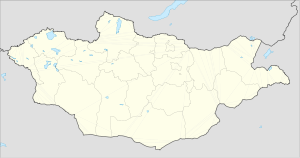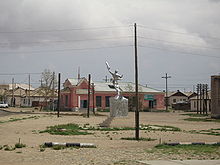- Choir, Mongolia
-
For other uses, see Choir (disambiguation).
Choir
Чойр— Town — Train station of Choir, Mongolia Location in Mongolia Coordinates: 46°21′38″N 108°21′54″E / 46.36056°N 108.365°ECoordinates: 46°21′38″N 108°21′54″E / 46.36056°N 108.365°E Country  Mongolia
MongoliaProvince Govisümber Sum Sümber Population (2002) - Total 7,588 Time zone UTC+8 Choir (Mongolian: Чойр) is a city in Mongolia. It is the capital of Govisümber Province, in the east-central part of the country. Choir is a center of the Sümber sum of Govisümber Province.
Contents
Population
In 2002 a population of Choir city was 7,588 (and 9,207 with rural parts of Sümber sum),[1] up from a population of 4,500 in 1979.[2] For the end of 2006 estimations population was 7,998.[3]
Geography
Choir lies in the Choir Depression, a lowland strip about 150 km long and 10 to 20 km wide, about 500 m lower than the surrounding upland.[4] It lies at an altitude of 1269 m.
Communications
It lies along the Trans-Mongolian Railway, 250 km to the southeast of Ulan Bator. The Asian Development Bank is considering a 430-km paved road from Choir to the Chinese border, the final stage of a north-south route through the country.[5]
History
Choir was a military base during the Soviet period. In 1989, the Soviet anti-aircraft missile units left Choir.[6] The longest runway in Mongolia, now abandoned, is located 25 km N from Choir, a relic of that period.[7] In 1992, the military cantonment passed into the jurisdiction of Govisümber Province, according to the 1992 constitution.[8] Near the railway station is a statue commemorating Mongolia's first cosmonaut, Jügderdemidiin Gürragchaa.
Economy
Choir has been declared a free enterprise zone.[7] Along with Darkhan and Erdenet, it is one of three autonomous cities in Mongolia.[9] Choir has a medium-security prison with 460 prisoners.[10]
Notes
- ^ Gobisümber aimag official site
- ^ "Mongolia". citypopulation.de. http://www.citypopulation.de/Mongolia_d.html. Retrieved 2007-07-24.
- ^ Govisümber Aimag official site
- ^ Denison Mines (December 2006). "Annual Information Form" (pdf). p. 62. http://www.denisonmines.com/files/objects/2006%20AIF%20FINAL.pdf. Retrieved 2007-07-24.
- ^ "Paving the Way for Road Development in Mongolia's Southern Gobi". Asian Development Bank. http://www.adb.org/media/printer.asp?articleID=1534. Retrieved 2007-07-24.
- ^ Alan J. K. Sanders, "Mongolia in 1989: Year of Adjustment," Asian Survey 30:1 (January 1990), p. 62.
- ^ a b "Mongolia, Multimedia Memories, and Me". Technos Quarterly. Winter 2001. http://www.ait.net/technos/tq_10/4mongolia.php. Retrieved 2007-07-24.
- ^ Alan J. K. Sanders, "Mongolia's New Constitution: Blueprint for Democracy," Asian Survey 32:6 (June 1992), p. 507.
- ^ Hari D. Goyal, "A Development Perspective on Mongolia," Asian Survey 39:4 (July/August 1999), p. 634.
- ^ "Siberian Team blesses Mongolia's prisoners". Asian Outreach International. Archived from the original on 2007-09-14. http://web.archive.org/web/20070914020527/http://www.asianoutreach.org/articles.php?lng=en&pg=162. Retrieved 2007-07-24.
External links
Capital: Ulaanbaatar Choir, Govisümber · Mandalgovi, Dundgovi · Dalanzadgad, Ömnögovi · Baruun-Urt, Sükhbaatar · Sainshand, Dornogovi · Altai, Govi-Altai · Bulgan, Bulgan · Öndörkhaan, Khentii · Choibalsan, Dornod · Ulaangom, Uvs · Uliastai, Zavkhan · Erdenet, Orkhon · Bayankhongor, Bayankhongor · Zuunmod, Töv · Khovd, Khovd · Darkhan, Darkhan-Uul · Tsetserleg, Arkhangai · Ölgii, Bayan-Ölgii · Sükhbaatar, Selenge · Arvaikheer, Övörkhangai · Mörön, Khövsgöl
 Categories:
Categories:- Aimag centers
Wikimedia Foundation. 2010.



